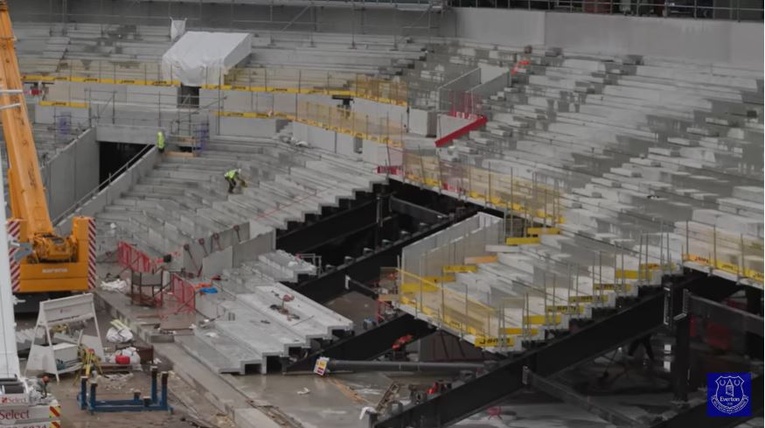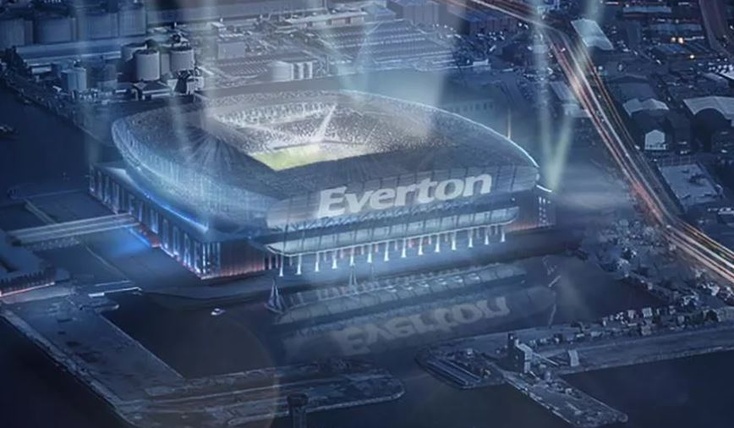
There is plenty for Everton fans to be worried about around their club at the moment. Having seen one of the prospective buyers drop out because they themselves are close to going out of business, another one decided to step away when the amount of debt the club has as well as the way that is structured was not something that they wanted any part of.
The owner, Farhad Moshiri, has been borrowing more and more debt in order to keep the lights on, but things aren’t great all round. The one bit of good news for the Blues is the fact that their new stadium is now months away from opening, so how did it get to this point?
A Build Full of Issues
The first time that a discussion was had around Everton getting a new stadium was in 1996, with a site new King’s Dock being identified five years later. Funding difficulties meant that that was abandoned, with a new plan to move to Kirkby then mooted. That was rejected by the central government, leading to a brief suggestion that Liverpool and Everton should share a ground built in between Goodison Park and Anfield in Stanley Park.
Obviously no one on either side was all that keen about that, so in the September of 2014 it was revealed that Everton were looking at a site in Walton Hall Park. That was scooped in 2016.
@liverpoolworldsportuk Bramely-Moore Dock Everton stadium update! #evertonfc #everton #premierleague #bramleymooredock #football #footballstadium #fypシ #merseyside
In the September of 2017, Bramley-Moore Dock was revealed as the club’s preferred location. It was endorsed after public consultation in 2018, even though UNESCO warned that building it would put the waterfront’s World Heritage Site status under threat, later removing it. Dan Meis was charged with designing the new stadium under the title of The People’s Project.
A lease with Peel Holdings that would last for 200 years was agreed in the November, with plans revealed in 2018 for a 52,000-seat venue that could be expanded to 62,000 seats. At Everton’s 2018 AGM, the funding plans were revealed that saw costs grow to around £500 million.
South Stand bar undergoing transformation. 🍻 pic.twitter.com/t5R5m0so2L
— Everton Stadium (@EvertonStadium) July 31, 2024
The construction of the site began in July 2021, seeing the main contractor in Laing O’Rourke begin the work of demolishing non-listed structures as well as removing and preserving heritage assets. The dock basin was repaired and in-filled, whilst the superstructure of the stadium was pieced together. Sadly, work had to be stopped in the August of 2023 when a worker and Everton fan, Michael Jones, suffered severe head injuries, later being declared dead at Aintree University Hospital.
The club planned a tribute to the supporter, declaring him to be ‘forever in our hearts‘. Work resumed after Merseyside Police had concluded their investigation into the accident.
What it Will be Like

The stadium was finally declared structurally complete when the final concrete terracing panel was put in place in the February of 2024. Unfortunately, another issue was to hit the build the following month when the company supplying cladding panels on the stadium’s exterior, Alucraft Systems, went into administration whilst owing around £8 million to suppliers.
The estimated final costs for the ground will be in the region of £750 million, being visible from the Wirral as it is right on the River Mersey. Boasting a final capacity of 52,888 and having a steel and glass construction, the stadium will also have a single-tier stand based loosely on the one in Germany.
At the Westfalenstadion, the ‘yellow wall’ has enough room for 25,000 supporters. The South Stand at the Tottenham Hotspur Stadium is for 17,500 people, making it the largest single-tier stand in the country. For Everton, the single-tier stand will house 13,000 people.
When it comes to the likes of hospitality, the club’s ALL experience is designed to ensure a wide choice of social spaces that will include pubs and bars as well as high street-style restaurants. Obviously there will also be high-end fine-dining experiences for those paying the most. The only thing that the stadium can’t guarantee is the quality of the football on display.
